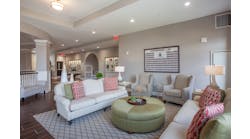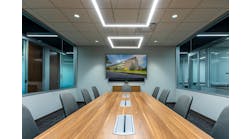Despite almost three-and-a-half centuries of knowledge showing how powerful and beneficial color is to humankind, white continues to be used as the traditional and safe choice for walls in school and college classrooms.
It has been proven that humans need sensory variety, and sensory variety is provided by color hues on walls in classroom environments. Proper color usage on classroom walls creates an enriched learning environment that increases student achievement, accuracy, instructor effectiveness and staff efficiency. An enriched learning environment is one of the keys to successful academic performance and provides a “feel good” atmosphere that can stimulate positive emotion. It can induce more productive learning, student creativity, and promote collaboration, interpersonal and organizational skills. It also boosts morale and can provide a feeling of security for students.
Johann Goethe, author of Theory of Colours, described the sensory perception of color by how the brain reacts to color once it is viewed. The mind is excited through a specific sensation, which can cause optimal and emotional influences on well-being. Viewing color has a thought-provoking effect; the visual stimulation helps a person retain information. This same principle can help schools increase students’ learning retention.
Today’s walls
The majority of education facilities use paint for the finish on classroom walls because of its cost-effectiveness. Adding color to interior walls helps stimulate students’ brains and can create an improved learning environment that boosts students’ academic performance, simply by being visible on the walls of the room during class time.
Multiple case studies demonstrating the benefits of colored classroom walls compared with white walls have been conducted. As far back as 1953, A.H. Rice concluded in a study of elementary school students that carefully planned paint schemes using color positively affected the student’s academic achievement.
Twenty years later, S.P. Papadatos provided evidence that by changing a sterile classroom environment lacking in color stimulation to one using color, the atmosphere was transformed from depressing to one that was exciting and pleasing. The increase in psychological positivity in turn increased stimulation and academic performance. Papadatos concluded that adding such color schemes in schools would lead students and teachers to have more positive feelings about their school, and less absenteeism.
Along with being “constructively useful,” color’s ability to provide an enriched learning environment also causes creativity to flow and positive emotions to arise; when placed together, these are the requirements for long-term memory storage to occur. When used properly, color in the classroom does not appear to lead to any negative outcomes.
Learning behaviors
Being in a safe and comfortable learning environment infused with color proves to be an excellent foundation to provide the stimulation that generates concentration for learners to focus on educational tasks.
A case study conducted by Ellen Grangaard of the University of Nevada in a 1993 dissertation concluded that using colored walls in elementary classrooms (with the addition of full COLOR 3 spectrum lighting) instead of white walls and cool-white fluorescent lighting reduced students’ blood pressure and reduced off-task behaviors by 22 percent. Students were able to stay on task with a calmer demeanor. This resulted in better academic performance with fewer errors, increased speed and with the added benefits of more healthful behavior. Although people learn differently, one common denominator is that they learn more efficiently when feeling secure and comfortable. Using colored walls in classrooms can achieve this type of welcoming setting.
So how does the power of color to enhance the perception of the environment correlate with the attainment of knowledge? Color has an ability to bring Gestalt- and analytic-type learning styles together by connecting the right and left hemispheres of the brain, which teams the skills of interaction and task mastery. This is especially important in today’s society, whose common usage of visual electronic devices support right-brain stimulation while suppressing the left brain.
As education institutions see increasingly, advancements in technology have become a plague against books and the conditioned use of the left hemisphere of the brain that translates text into imagery. Color’s properties stimulate the psyche and enable the two hemispheres to join forces. Reactions to color occur spontaneously because of the enhanced alertness and altered level of brain wave activity. This is not a novel discovery; this type of process was documented by Rikard Kuller’s case study in 1976. He used color and visual patterning to show how the entire central nervous system is affected through visual stimulation. A person benefits from this mental clarity and acquires higher levels of energy because of an increased production of hypothalamic hormones.
One of the most impressive case studies on color linked to learning behavior in classroom environments began in 1957 by Heinrich Frieling, the founder of the Institute of Color Psychology. In his study, Frieling used a sample of more than 10,000 children across the globe and focused on their color preferences and behaviors while situated within classroom spaces that have colored walls. Younger children inhabiting classrooms with their color of choice exhibited lower levels of nervous tension, and older children had increased concentration levels. Both of these behavior‐changing attributes brought about better focus and resulted in the improved learning from all the students.
An additional teacher
Color has the power to keep students in classrooms through the psychological benefits it provides to all inhabiting that space. It can unconsciously stimulate a brain to achieve more academically and improve teaching performance. The use of colored classroom walls seems to be equivalent to having an additional “teacher” that provides motivation and encouragement for learners to excel. This teacher (colored wall) does not negatively affect budgets or overhead expenses and can reach all students simultaneously and without interruption on a personal level.
Using diverse color values also can provide a more comfortable environment for educational spaces with restrictive architectural elements, such as low ceilings and absence of windows. By selecting warmer or cooler colors, the illusion of a larger or brighter space can be achieved at no more cost than providing simplistic values of white. Although color has many different viewpoints and positions for its use, the power of its capabilities to achieve increased academic performance and boosted morale when used in classroom environments stands undisputed.
The question is, why are colored walls not employed as a design standard in the educational facilities across America? With the centuries of color research concretely pointing to the positive aspects of it use in classroom environments, it seems to be a no-brainer.
Grube, MID, LEED AP ID+C, NCIDQ, is an assistant professor of interior design at Johnson County Community College, Overland Park, Kan.


